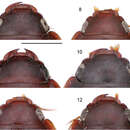Description
provided by Zookeys
Head (cf. Figs 7–12) with two supraorbital setigerous punctures per eye near their posterior corner, however, numerous accessory setae in some groups obscure them; frontal impressions absent. Clypeus markedly wide, trapezoidal with rounded anterior angles and shallowly lobed posterior margin; posterior margin in some adults very shallow, or effaced, bearing a single long seta each side near anterior corner. Eyes flat, or slightly convex; small gena with numerous stout setae. Antenna of varying length, either shorter, or longer than distance from antennal base to anterior coxae; antennomeres 3–9 slightly wider distally and appearing flattened. Labrum visible, about 2/3 as wide as clypeus, rectangulate, bearing six setae along anterior margin. Mandible markedly flattened with a very short and acute apex; outer margin ventral of the scrobe with short stout setae. Maxillary palpi markedly short, 3-segmented, palpomeres slightly depressed, palpomere 3 truncate apically. Labial palpus with short bisetose palpomere 2; palpomere 3 markedly securiform and robust, its distal margin mostly membranous with sensory organs.
Prothorax. Pronotum (cf. Figs 1–6) wider than head, transverse, with broadly explanate margins, or in cylindrical species narrowly explanate margins; without a pair of setigerous punctures each side, apical, lateral and posterior margins with border of stout setae; hind angles obtuse, broadly rounded. Proepisternum with prosternal process multisetiferous apically, intercoxal process feebly margined.
Pterothorax. Metepisternum elongate though not exceptionally so, the outer margin about 1.5 times greater in length than the anterior margin, posterior margin about 0.5 times anterior margin.
Elytra. Elytron rectangulate, slightly narrower apically, wider or narrower (depending on species group) than pronotum at widest point, apical margin subtruncate, outer margin broadly rounded, interneurs present or effaced, of fine or course punctures; parascutellar stria present or absent, parascutellar puncture present, marked; intervals flat to slightly convex without fixed setae, rather variously setiferous, or glabrous. Lateral marginal (umbilical) series of 10–15 setae, concentrated and narrowly spaced in anterior third, widely spaced in posterior two-thirds; lateral margin with border of stout setae.
Hind wings. Macropterous. Venation not studied (see Baehr 1997 for illustration of related species, and Erwin 2013).
Legs. Short and depressed, femur posteriorly channeled for reception of tibia in repose; antennal comb notch very shallow; tibial spurs normal; anterior tarsi of male with tarsomeres 1–2 dilated slightly, ventrally with two rows of adhesive articulo-setae.
Abdomen. Abdominal sterna III-VII with patches of short setae and each of IV–VII with a single row of erect ambulatory setae numbering 2 to 8 setae; V and VI in male with dense row of yellowish robust setae medially.
Male genitalia (cf. Figs 13–16). Phallobase hooded with small orifice, dorsum crested or not; phalloshaft straight or markedly arched at basal third, diameter sub-rounded or somewhat depressed dorso-ventrally; phalloapex produced, acute or rounded, depressed dorso-ventrally; endophallus with scattered microtrichia, not in patches. Parameres large, nearly equal in length, left slightly longer and broader than right, each apically glabrous or setiferous.
Female ovipositor (cf. Fig. 17). Gonocoxite 2 (gc 2) falcate, base (b) about as long as blade (bl), latter relatively short, pointed distally; margins with several ensiform setae (en); with or without short preapical nematiform setae (n).
The species groups of Pseudomorpha Kirby 1825 and their known distributions (note that some species group names are based on yet undescribed species in Erwin in prep.)
Alleni group. AZ, UT
Augustata group. AZ, CA, NV, NM, TX, UT, México
Behrensi group. CA, CO, ID, NV, NM, OR, UT
Caterinoi group. CA
Consanguinea group. AZ, CA
Cronkhitei group. AZ, CA
Chumash group. CA
Cylindrica group. NM, TX, México
Excrucians group. AR, GA, LA, MS, SC, Argentina, Brazil, Dominican Republic
Falli group. CA
Hubbardi group. AZ, NM, TX
Parallela group. CA, Haiti
Peninsularis group. AZ, CA, CO, NV, NM, OR, UT, México
Phiara group. TX
Pilatei group. TX, Costa Rica, Guatemala, México
Santarita group. AZ, NM, México
Subsulcata group. NM
Tenebroides group. AZ, CA, NV, NM, UT
Vindicata group. CO, ID, UT
(Taxa referred to in the key are arranged alphabetically in the Species Group Account below) 1 Pronotum planar, aspect apparently flat with anterior margin on same plane as posterior margin (Figs 1, 2, 4, 5, 6) 2 1’ Pronotum not planar, aspect humped, anterior margin lower (in lateral view) than posterior margin (Fig. 3) Pseudomorpha penablanca Amundson & Erwin, sp. n. 2(1) Elytron with intervals slightly convex and easily observed with low power magnification (Figs 2, 4) 3 2’ Elytron with intervals effaced and not obvious with low power magnification (Figs 1, 5, 6) 4 3(2) Small-sized for group, ABL = 4.9 to 5.2 mm, and dark rufous with forebody paler than elytra; margins of elytra parallel in basal two-thirds (Fig. 2) Pseudomorpha patagonia Erwin & Amundson, sp. n. 3’ Large-sized for group, ABL = 6.3 to 6.8 mm, and completely piceous; margins of elytra tapered toward apex (Fig. 4) Pseudomorpha pima Amundson & Erwin, sp. n. 4(2’) Eye flat in dorsal view, not protruding beyond gena/preocular lobe plane (Figs 7, 11) 5 4’ Eye slightly convex in dorsal view, protruding beyond gena/preocular lobe plane (Fig. 12) Pseudomorpha santarita Erwin & Amundson, sp. n. 5(4) Pronotum wider than elytra across humeri (Fig. 1); preocular lobe of even width throughout (Fig. 7) Pseudomorpha huachinera Amundson & Erwin, sp. n. 5’ Pronotum slightly narrower than elytra across humeri (Fig. 5); preocular lobe slightly wider anteriorly (Fig. 11) Pseudomorpha santacruz Erwin & Amundson, sp. n.
- license
- cc-by-3.0
- copyright
- Terry L. Erwin, Lauren M. Amundson
- bibliographic citation
- Erwin T, Amundson L (2013) Beetles that live with ants (Carabidae, Pseudomorphini, Pseudomorpha Kirby, 1825): A revision of the santarita species group ZooKeys 362: 29–54
- author
- Terry L. Erwin
- author
- Lauren M. Amundson


 Pseudomorpha sp.
Pseudomorpha sp.